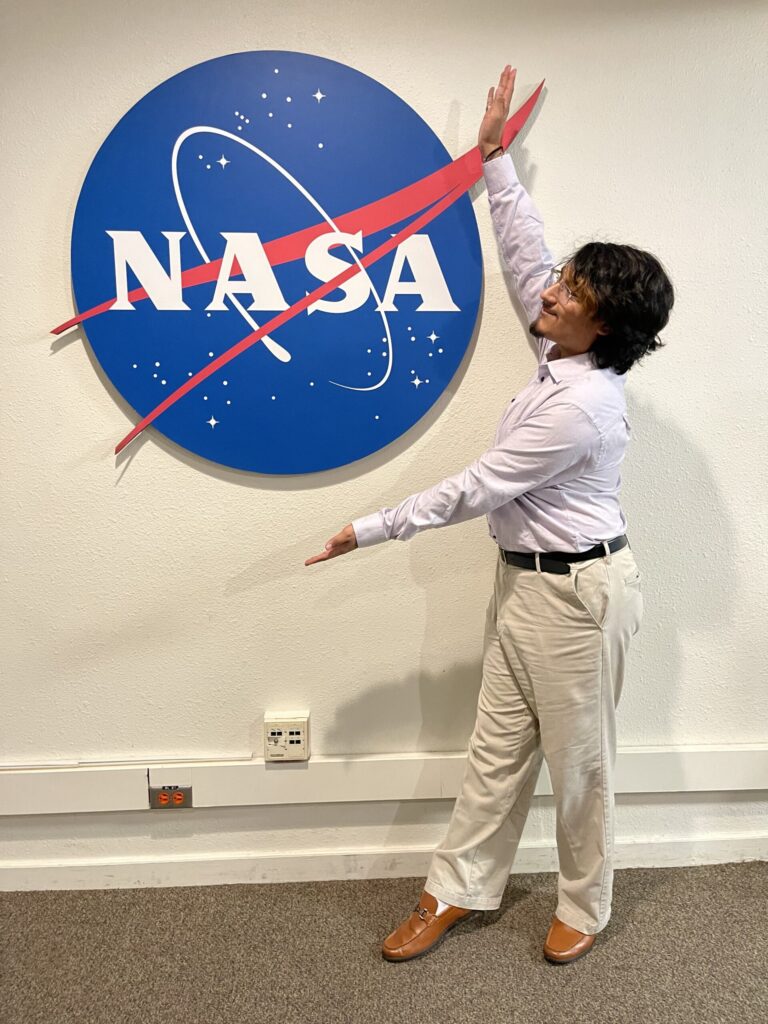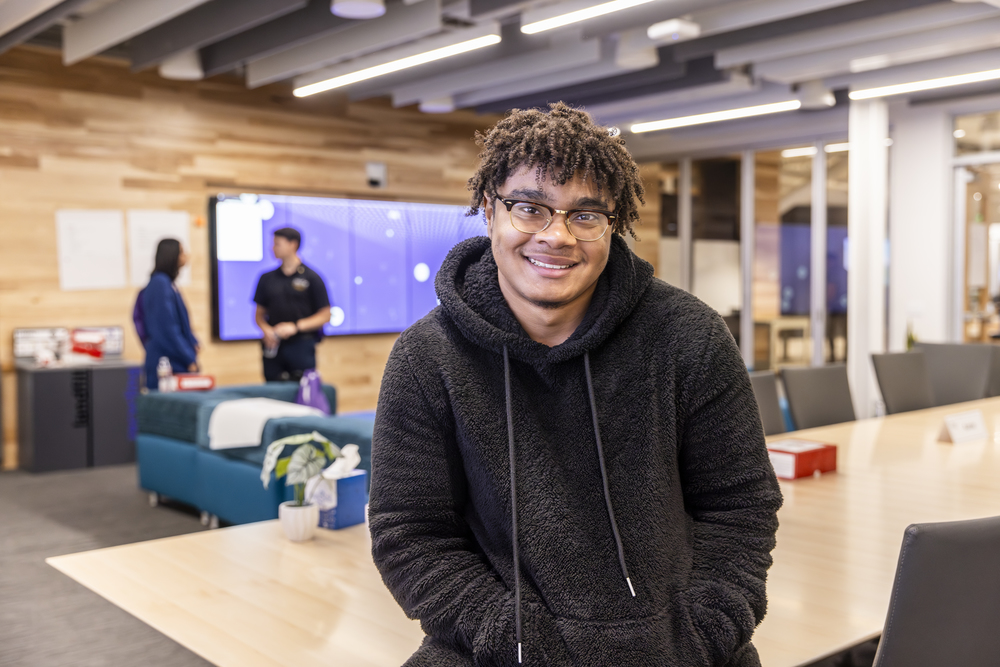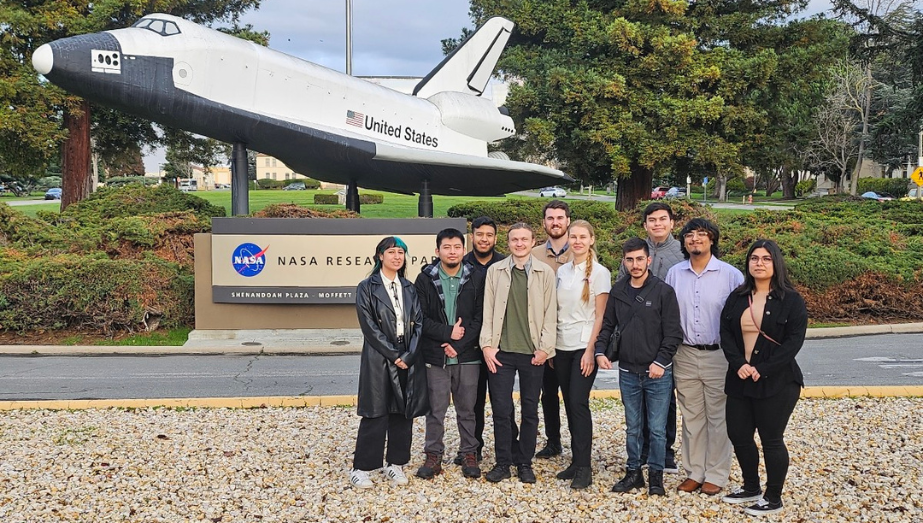Two ACC students recently had the opportunity to work with NASA. They share their experiences and how they have taken their passions out of this world.
Juan Manuel Monsivais-Peña

Imagine working side-by-side with NASA engineers to dissect challenges and develop solutions.
Austin Community College District (ACC) student Juan Manuel Monsivais-Peña doesn’t have to imagine — he just lived the experience.
Thousands of students across the nation applied for the special NASA Community College Aerospace Scholars (NCAS) program, and Juan was one of a select few hand-picked for the journey.
He worked with teams at NASA on a series of missions to develop possible solutions for current challenges faced by NASA.
“I was surprised that I was given an offer to join. I didn’t think I would qualify when I found the opportunity, but I submitted my application. When I was told I was selected, I realized that, regardless of doubting my skills and myself, pushing myself is the way to go.”
NCAS gives community college STEM students an authentic NASA experience and encourages them to finish an associate degree and transfer to a four-year university to pursue a NASA-related field. Juan plans to complete his General Studies degree in spring 2024, followed by finishing his second degree in Biology by the end of the year.
“After this experience and being at Ames Research Center, I decided to transfer to the University of Texas at Austin and would like to pursue Astrobiology.”
Juan completed all three NCAS missions, which helped him build on all the skills he was learning.
“Every step of the way taught you something you could apply to the next mission. Mission 1 taught us how to research and condense our information. Mission 2, we were assigned into teams and worked only for a week with no prior introductions, straight into teamwork and research. In Mission 3, we worked with an assigned team for two weeks online to do research for a drone proposal. We then went onsite at Ames Research Center.”
The experience provided Juan with the training and opportunity to see where he wanted to go and pursue his career.
“I hope to intern and even get a job working with NASA. This opportunity shows people how NASA works. You get to learn about the experiences and the journey. I feel that we put NASA workers in this place — they are above people because they’re so smart, and in reality, they are down-to-earth people.”
Ronald Ngamby

Thinking about pursuing a degree in Business Administration and Accounting, your first thought might be working in a standard office setting. For ACC student Ronald Ngamby, he was surprised to find that he could apply to NASA as a Business major.
Ronald is back from completing his third mission with the special NASA Community College Aerospace Scholars (NCAS) program. He began at ACC in August 2021 and plans to transfer to either the University of Texas at Austin or Texas A&M at College Station. Read more about his story below.
Written by Ronald Ngamby, ACC Business Administration and Accounting Student
GETTING STARTED: MISSION 1
I applied to the NASA program because I was looking for internships first. I realized the internships I was looking at would force me to move to Houston, and I couldn’t do that. When I saw NCAS Mission 1 Discover was a virtual program, I said, “Why not?” and went for it.
My mindset was you always have a chance when you apply, but when you never try to apply, you have zero chance to make it. When I found out I was selected, I was ecstatic. I was surprised because when you think of NASA, you think only of STEM-related fields, but that’s not true. NASA has jobs for almost every major.
The five-week program started in the summer of 2023. We learned and researched NASA’s mission goals and multiple directorates. We would submit papers answering specific questions about these directorates and explaining what we learned. At the end of the program, we created a final infographic, putting together all the knowledge we gained from Mission 1. In Mission 1, there are around 300 students, but on Mission 2, there are around 180 students. In my experience, doing your work on time, answering all the questions properly, and finishing each assignment will allow you to continue to Mission 2.
MOVING FORWARD: MISSION 2
There are two sets of Mission 2, but instead of five weeks like Mission 1, it’s one week in the fall. My Mission 2 was to Explore, where we were put in a team of 10 and assigned to a specific role. In this mission, you simulate a job and work with a team to create a presentation for NASA panelists. The challenge we were given was to land a rover on the moon and explain its purpose and what we would achieve. For my specific role, I was a Floor Specialist operationalist. In simple terms, I’m supposed to map out the coordinates of the moon where we will land, our travel plan, and what we are doing on the moon’s surface.
Yes, you’re probably wondering how the heck I did that in a week. Trust me, NASA gives you lots of valuable resources and has professionals in each job you’re assigned. You go to meetings every day so you can understand what’s going on. It seems like a lot, but it will be alright if you work with your team and ensure you have fun.
The NASA panelists will also have questions and critiques once you finish Mission 2. To be accepted into Mission 3: Innovate, you must combine the individual scores of your Mission 1 and Mission 2.
THE FINAL OPPORTUNITY: MISSION 3
Mission 3 is a three-week program. The first two weeks are virtual and hosted online. The third week is an opportunity to meet in person at a NASA research center.
For me, I was flown to the AMES Research Center in San Jose, California. Before you can make it there, you must work in a team of 10 to face a given challenge. Our specific challenge revolved around the NASA Advance Air Mobility program (AAM), specifically Consumer Enterprise and goods and services.
The goal was to identify a problem and propose a potential solution. During the two weeks online, we worked to create a final proposal that we would then present to NASA panelists in person. Once you get to the in-person portion, you get to tour the NASA research center, learn more about what they do at that specific center, and even talk to amazing people at NASA.
We also visited the University of California, Berkeley, which was an incredible experience. It’s a great networking opportunity, learning experience, and a fun time. This also helps you with presenting skills and the pressure of speaking to people you may not be comfortable speaking to. You will learn more about yourself taking on these missions and learn to work with a team.
Don’t worry about what major you’re studying or if you think you’re not up to the challenge. Anyone can do this, especially if you come into it with an open mind and ready to learn. You will surprise yourself with your capabilities, and I know that all ACC students can tackle this challenge or any other opportunities that ACC or the world provides. Just believe in yourself, because I’m just a business major who was able to go to space.

